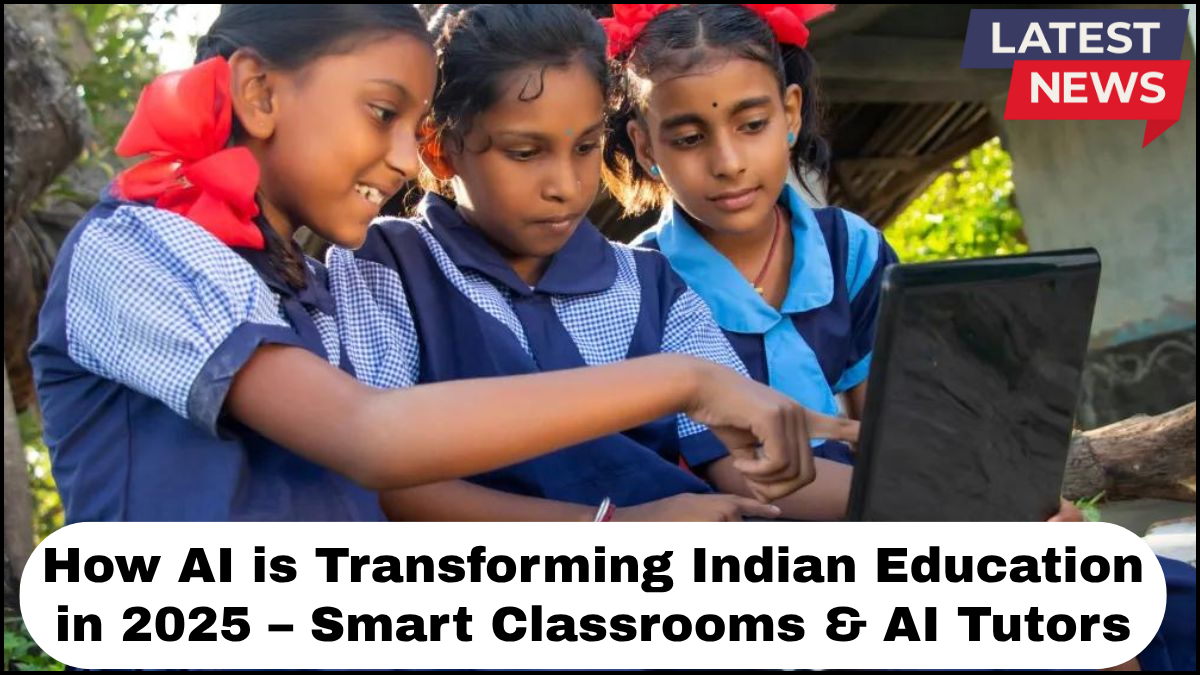In 2025, AI in Indian education has moved far beyond buzzwords. It’s reshaping how students learn, how teachers teach, and how schools operate. The traditional classroom is evolving into a smart, data-driven ecosystem where artificial intelligence supports personalized learning and real-time feedback.
From smart classroom automation to AI-powered tutoring systems, India’s education landscape is undergoing a massive transformation driven by technology.

The Rise of Smart Classrooms: Automation Meets Engagement
Smart classroom automation has become a cornerstone of modern schools in India. Equipped with interactive boards, AI-based attendance systems, and real-time performance tracking, these classrooms enhance both teaching efficiency and student engagement.
AI-driven sensors can now monitor students’ attentiveness during lectures and adjust the content delivery accordingly. For example, if the system detects declining attention levels, it can prompt the teacher to shift strategies—perhaps using a visual explainer or gamified quiz to re-engage learners.
Moreover, lesson plans are no longer static. AI platforms analyze student performance data and suggest changes to content delivery, helping teachers tailor material for different learning speeds and styles.
Personalized Learning Through AI Tutors
AI tutors are among the most impactful innovations in AI in Indian education 2025. These systems offer one-on-one, adaptive support that mimics human tutors but operates 24/7. Whether it’s solving a math problem or learning a new language, AI tutors provide instant feedback and custom-tailored exercises.
Platforms like BYJU’S, Vedantu, and Toppr have already integrated AI to deliver personalized learning journeys. In 2025, these systems now use deeper learning analytics to identify weak spots, recommend revision modules, and even adjust learning difficulty dynamically.
For rural and under-resourced areas, AI tutors are bridging the education gap. With just a mobile device and internet access, students can now receive high-quality academic support without needing physical coaching classes or expensive tutors.
Empowering Teachers, Not Replacing Them
Despite misconceptions, AI isn’t here to replace teachers—it’s here to empower them. With automated grading, lesson planning support, and predictive analytics, teachers spend less time on administrative work and more time on student engagement.
For instance, AI can flag at-risk students by analyzing patterns in attendance, performance, and behavior. This early warning allows teachers and administrators to intervene before the problem escalates.
Professional development has also seen an AI boost. Teachers now access AI-powered platforms that recommend courses, training videos, and teaching techniques based on their subjects and experience levels.
Revolutionizing Assessments and Feedback
Traditional exams are giving way to continuous, AI-based assessments that measure not just memory retention but critical thinking and problem-solving skills. Instead of waiting for midterms or finals, educators get instant insights into student understanding after every topic or module.
AI tools now grade subjective responses with surprising accuracy, using natural language processing to evaluate grammar, structure, and logic. This ensures faster feedback cycles and reduces manual bias in assessments.
Making Education More Inclusive and Accessible
In 2025, AI tools in Indian education have become pivotal in addressing accessibility challenges. Text-to-speech and speech-to-text features help students with visual or hearing impairments participate more effectively. AI-powered translation services are breaking down language barriers, offering regional language support in multilingual classrooms.
This inclusivity extends to students from economically weaker backgrounds. Many EdTech platforms now offer AI-driven learning modules at reduced costs—or even for free—thanks to government and CSR-backed initiatives.
Challenges and Considerations
Despite the advancements, challenges remain. Data privacy, algorithmic bias, and unequal access to infrastructure continue to pose risks. Ensuring that AI systems are ethical, transparent, and accessible to all communities is essential for long-term success.
Regulatory bodies like the CBSE and UGC are beginning to draft AI integration guidelines to balance innovation with responsibility.
The Road Ahead
By 2025, AI in Indian education is no longer an experiment—it’s the new normal. As smart classroom automation and AI tutors become ubiquitous, India is laying the groundwork for a future where learning is personalized, inclusive, and future-ready.
But the journey doesn’t end here. Continuous investment in teacher training, infrastructure, and ethical AI development will be crucial to sustaining this momentum.
FAQs
1. What is AI’s role in Indian education in 2025?
AI supports personalized learning, automates classroom processes, and helps track student progress. It also provides real-time analytics to improve teaching and learning outcomes.
2. How are AI tutors different from traditional teaching?
AI tutors offer one-on-one learning experiences that adapt in real-time to a student’s needs. They work around the clock and personalize content based on student performance and learning style.
3. Are smart classrooms only for urban schools?
Not anymore. With increasing access to mobile technology and government support, smart classroom automation is expanding to semi-urban and rural schools as well.
4. Does AI replace teachers?
No. AI acts as a support tool, helping teachers with administrative tasks, personalized content, and early intervention alerts. Teachers remain central to the learning process.
5. What challenges does AI in education face?
Key challenges include data privacy, digital inequality, infrastructure gaps, and ensuring AI tools are inclusive and unbiased.
click here to learn more
